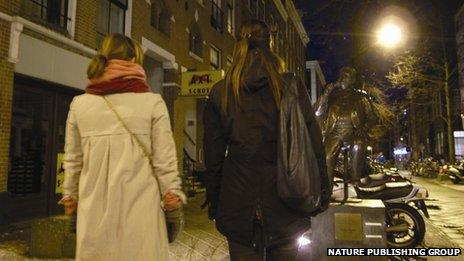Could electroconvulsive therapy zap worst nightmares?
- Published
Memory zapping study
Electroconvulsive therapy (ECT), long associated in the popular imagination with controversial treatment of the mentally ill, can be used to erase memories, Dutch researchers have found - raising hopes of a new treatment for post-traumatic stress disorder.
They say that, in the end, memories are all we have left. And yet how many times have you wished you could forget something?
Now new research suggests it may be possible to zap specific memories, with the help of ECT, a controversial psychiatric treatment where electric pulses are passed through the brain.
Dr Marijn Kroes, of the Donders Institute for Brain, Cognition and Behaviour at Radboud University Nijmegen, who led the study, says the treatment appears to disrupt the natural process of storing memories in the brain.
Last-resort treatment
"Memories are stored in connections between cells in your brain," he says. However, these connections take some time to become permanent.
"If you disturb [this] process, you lose the connection between cells altogether" - and thus lose the memory.
ECT is still used in the Netherlands, Britain and many other countries as a last-resort treatment for severe depression.
According to the psychiatrists who use it, the treatment's bad reputation is partly down to films such as One Flew Over the Cuckoo's Nest, external, in which a terrified patient is strapped down and forced to endure violent seizures.
The picture is very different in the Rijnstate medical centre where the memory-erasing experiments were conducted.
Inside a bright, modern operating theatre, Dr Jeroen van Waarde treats between 20 and 30 patients every week with ECT.
To administer the treatment, steel pads are attached just above the patients' temples. Wires connected to the transmitter device send electric pulses through the brain, inducing a seizure similar to an epileptic fit.
In earlier times, the whole body would stiffen and thrash about. These days, the combined effects of muscle relaxants and a general anaesthetic mean that most of the body remains still during the seizure. The only visible sign is the twitching of one arm that has a tourniquet attached.
Target specific memories
One of the known side-effects of ECT is memory loss. According to the Royal College of Psychiatrists, that memory loss is normally temporary, but some patients report severe and long-lasting memory losses after ECT.
This study took advantage of this side-effect to see if it was possible to target specific memories.
Dr Kroes and his team conducted the memory-erasing research with patients who were already undergoing ECT as a treatment for severe depression.
Participants were initially shown two sets of picture cards, each telling an emotional story.
A couple of weeks later, just before an ECT session, they were shown just one of the sets of story cards again, in order to activate that particular memory.

Participants were shown pictures that told a story and asked to recall them after ECT
When asked to recall the stories 24 hours later, they could not remember the story they were shown just before having ECT. The memory of the other story - which they had not seen for two weeks - was unaffected.
Ineke Brussard took part in the study. She was being treated for debilitating depression at the Rijnstate clinic and and is now "happy." She cannot remember what she was shown before the ECT.
"They showed me something, but I don't remember that it was that card, or such a card, or whatever, no. I don't remember."
The research aims to harness a cognitive process known as memory reconsolidation.
Each time memories are accessed, they are taken out of the storage compartment in the brain and "rewritten" over time, before being relayed to the brain's internal mechanisms.
Results from previous animal studies show that, during that reconsolidation, memories are sensitive to being altered or even erased.
This new Dutch research suggests it may be possible to get rid of specific memories by accessing them - in this case, priming them by looking at pictures - just before receiving ECT.
'Traumatic memories'
Dr Kroes is optimistic it could eventually be used by patients with post-traumatic stress disorder (PTSD), a debilitating memory-related illness.
"Traditional treatments teach you how to deal with your traumatic memories, but they don't change your traumatic memories. So what we're looking for now is a way to 'erase' these."
There is still a long way to go before patients are prescribed this kind of memory-altering treatment.
The research was based on artificially generated memories using story cards as prompts, so the next step is to find out if real, long-term traumatic memories - which are more deeply ingrained in our brains - can ever be subject to the same targeted or "spot-cleansing" process.
But for those whose memories have an incapacitating impact on their lives, this research offers hope.
Simon Buckden, a veteran of the Iraq and Bosnia conflicts, is haunted by his war experiences.
He now suffers from PTSD, which he describes as "a 24-hour cancer that you have to fight every day until it kills you".
He says he would consider the ECT-based treatment if it were developed for clinical use.
"I wouldn't be the person I am today or have achieved so much if it wasn't for those experiences, but if it could take away the emotions that are connected to those memories then I'd try it, absolutely."